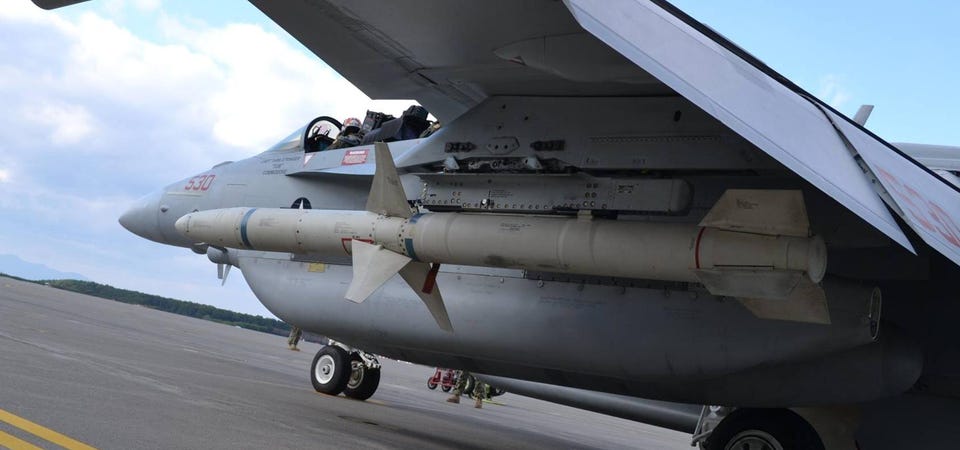With every new photo that circulates online, it’s becoming clearer—the Ukrainian air force’s trusty old MiG-29 fighters are on a mission to hunt down and knock out Russian air-defenses in Russian-occupied Ukraine. The ongoing suppression-of-enemy-air-defenses, or SEAD, campaign—pairing the twin-engine, single-seat MiGs with U. S.
-made High-Speed Anti-Radiation Missiles, or HARMs—represents a capability mismatch. The Ukrainians increasingly are capable of taking out Russian air-defenses, but the Russians are struggling to return the gesture and suppress Ukrainian air-defenses. That mismatch could reshape the battlefield in Ukraine as Russia’s wider war on the country grinds into its sixth month.
Oleksii Reznikov, Ukraine’s minister of defense, back in July teased the country’s acquisition of radar-homing missiles. But the first evidence of American HARMs in Ukraine came Aug. 7, when photos circulated online depicting wreckage of a missile somewhere in Ukraine—wreckage with the distinctive stenciling of a HARM.
More photos soon followed, the most recent on Thursday . In addition, a photo that appeared on social media on Wednesday purports to depict damage that a HARM inflicted on a Russian Tor-M2 air-defense vehicle. The initial photos sparked widespread speculation.
Since no air force ever has integrated the HARM on a Soviet plane type, some observers wondered aloud whether a NATO ally of Ukraine fired the missiles. That always was unlikely, of course, as NATO—while a strong supporter of Ukraine—carefully has avoided direct involvement in the Russia-Ukraine war, for obvious escalatory reasons. Alternatively, some observers pointed out that later models of the Raytheon-made AGM-88, which first entered service in the 1980s, are compatible with ground launchers.
Perhaps the Ukrainians had cobbled together some kind of improvised truck-launcher for older HARMs. On Aug. 8, U.
S. Undersecretary of Defense for Policy Colin Kahl ended the speculation. The Ukrainian air force was firing HARMs that the administration of U.
S. president Joe Biden transferred to Ukraine under Biden’s “presidential draw-down authority,” which allows him to dispatch overseas surplus U. S.
weaponry. “We’ve included a number of anti-radiation missiles that can be fired off of Ukrainian aircraft that can have effects on Russia radars and other things,” Kahl said. “So there are also things that we’re doing to try to make their existing capabilities more effective.
” Kahl even hinted at which of Ukraine’s roughly 100 remaining front-line warplanes are carrying the 14-foot anti-radiation missile. Kahl noted speculation that Ukraine quietly has been acquiring—or at least seeking to acquire—second-hand MiG-29s from NATO countries. “A lot was made about the MiG-29 issue several months ago,” Kahl said.
“Not very much has been noticed about the sheer amounts of spare parts and other things that we’ve done to help them actually put more of their own MiG-29s in the air and keep those that are in the air flying for a longer period of time. ” The aging MiG-29 is the Ukrainian air force’s most numerous type. Even taking into account wartime losses, it’s possible Kyiv still has 50 or more flyable MiG-29s.
Sure enough, last week unnamed Pentagon officials told Joseph Trevithick, a reporter for The War Zone, that Ukrainian MiGs were carrying the HARMs following some unspecified effort to integrate the missiles on the planes. The MiG-29 is the only MiG in Ukrainian service. We don’t know how many HARMs the Pentagon has given to the Ukrainian air force—the U.
S. last week pledged more as part of an $800-million aid package—nor how many MiGs the Ukrainians have modified to carry the missile. We also don’t know how many sorties the SEAD MiGs have flown nor how many targets they’ve struck.
But the photographic evidence is telling. It’s likely photos exist of only a minority of HARM strikes. If there are four batches of photos from recent SEAD strikes, it’s safe to assume there have been many times that number of SEAD missions, in total.
The damage to the Russian air-defense network is mounting. In addition to the damaged Tor, the Russians in recent days have written off a ZSU-23-4 self-propelled anti-aircraft gun. In all, the Ukrainians have knocked out or captured 91 Russian air-defense vehicles and guns and around a dozen radars.
The Russians meanwhile have taken out just 49 Ukrainian air-defense vehicles and guns and around 20 radars—testimony, perhaps, to the relative ineffectiveness of the Russians’ own SEAD efforts. The point of SEAD is to make safe for friendly aircraft—manned jets, helicopters and drones—the air space around the enemy’s front-line forces and rear-area logistical network. You know SEAD is working when you see more air strikes against targets that should be heavily-defended.
That clearly is happening across Russian-occupied Ukraine as more and more Russian trains, bridges, supply dumps and airfields explode. How many of those strikes owe their success to Ukrainian MiGs firing HARMs is impossible to say. But the Ukrainians aren’t shooting Russian air-defense for fun.
SEAD usually is a support effort within a wider campaign. And there’s no doubt Ukraine has launched a campaign of deep strikes. Thus it’s fair to describe Russian air-defenses as increasingly “suppressed.
”.
From: forbes
URL: https://www.forbes.com/sites/davidaxe/2022/08/26/ukrainian-migs-firing-american-missiles-are-hunting-down-russian-air-defenses/
